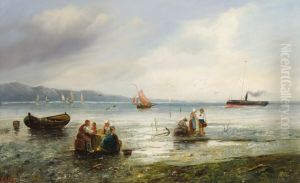G. Orban Paintings
G. Orban, born Georges Orban in 1884, was a Belgian artist known for his contributions to painting and graphic art. His work, which spanned the first half of the 20th century, reflects the various movements and stylistic changes of the period, including elements of Impressionism, Post-Impressionism, and early Modernism. Although not as widely recognized as some of his contemporaries, Orban's artistry and technical skill have earned him a place in the annals of European art history.
Orban's early life and education in art set the foundation for his diverse career. He was part of a generation of artists who were seeking new ways to express the rapidly changing world around them. His work often depicted everyday scenes, landscapes, and portraits, imbued with a sensitivity to light and color that reveals the influence of the Impressionists. However, Orban also experimented with more abstract compositions, illustrating the impact of Modernist ideas on his artistic development.
Throughout his career, G. Orban participated in numerous exhibitions, both in Belgium and abroad, helping to spread his reputation across Europe. His works were included in galleries and private collections, attesting to their appeal and the respect he garnered among collectors and his peers. Despite the challenges posed by the two World Wars, Orban continued to produce work that was reflective of his times, capturing the essence of the early 20th century European art scene.
Orban's contribution to art is also marked by his influence on younger artists. As a teacher and mentor, he played a role in shaping the direction of Belgian art, encouraging experimentation and a commitment to artistic integrity. His death in 1947 marked the end of a career that had spanned some of the most tumultuous and transformative decades in modern history, leaving behind a legacy that continues to inspire admiration and study.
In sum, G. Orban's life and work encapsulate a vibrant period in European art, characterized by exploration, innovation, and a deep engagement with the visual possibilities of the world. His paintings and graphic works not only offer insight into the aesthetic concerns of his time but also stand as enduring examples of artistic excellence.
